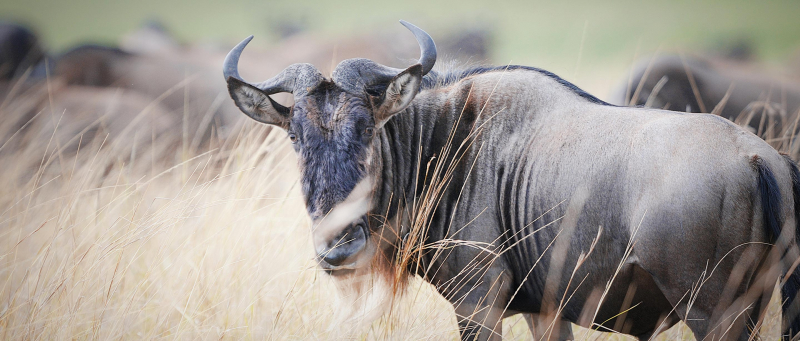Wildebeest
The wildebeest, also known as the gnu, is a captivating member of the antelope family. It boasts a large, box-like head and curving horns. Its body is a study in contrasts. The front end is heavily built, while the hindquarters are slender with spindly legs. Their coat is a distinctive gray, complemented by a black mane and beard. The beard can be black or white.
Several races of wildebeest roam the African plains. The western white-bearded wildebeest forms vast herds in the Serengeti-Mara ecosystem. Meanwhile, the eastern white-bearded race inhabits areas east of the Gregory Rift. The brindled or blue race is known for its darker color and lives south of the Zambezi River.
An adult wildebeest can weigh between 260 to 595 pounds. They stand up to 48 inches long. Despite their bulk, they are surprisingly agile. They are built for endurance, perfect for life on the open plains. In the wild, they can live up to 20 years. They thrive in open woodlands and grassy plains, constantly on the move.
As herbivores, wildebeests are always in search of fresh grass and water. Their diet drives their famous migratory behavior. The Serengeti population undertakes an annual migration of 500 to 1,000 miles each year. The journey starts after the calving season. It's a relentless pursuit of sustenance. During this time, many are injured, lost, or killed. By the end of the dry season, they return to the Serengeti plains as the rains begin.
Habitat fragmentation poses a significant threat to wildebeests. As land is fenced off for agriculture, their paths are disrupted. Along with water source reduction and poaching, their survival hangs in the balance. Organizations are addressing this by engaging with governments and communities. They propose solutions to habitat fragmentation and provide sustainable agricultural tools. These efforts aim for a balance between modernization and conservation.
Wildebeests are social and vocal creatures. Bulls are particularly loud with a range of sounds. An interesting aspect of their life is their calving behavior. About 80 percent of females calve within the same two- to three-week period. This strategy overwhelms predators and allows more calves to survive.
Key Takeaways:
- Type: Wildebeests are robust members of the antelope family.
- Size: They can grow up to 48 inches in length.
- Weight: Adults weigh between 260 to 595 pounds.
- Diet: They are herbivores, constantly searching for grass and water.
- Average Lifespan: They can live for up to 20 years in the wild.











